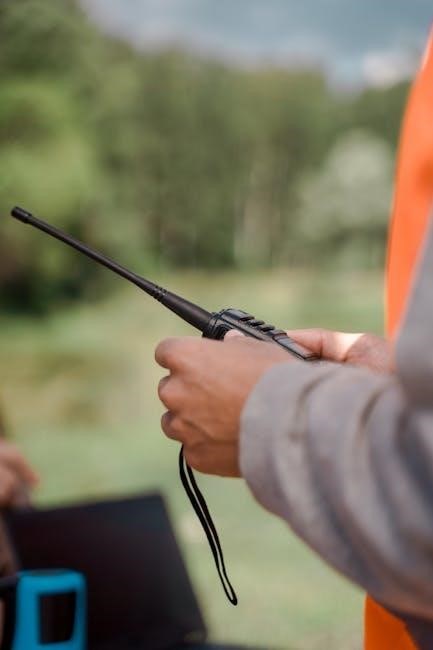
xnx universal transmitter user manual
The XNX Universal Transmitter is a flexible‚ reliable solution for industrial gas detection‚ designed to adapt to various environments and applications‚ ensuring precise monitoring and safety.
1.1 Overview of the XNX Universal Transmitter
The XNX Universal Transmitter is a highly flexible and reliable gas detection solution designed for industrial environments. It supports multiple sensor technologies and gas types‚ ensuring adaptability to various applications. With advanced communication capabilities‚ it integrates seamlessly into existing systems‚ providing real-time data for safety and efficiency. Its robust design and user-friendly interface make it a versatile choice for monitoring hazardous areas‚ ensuring accurate and dependable performance in demanding conditions.
1.2 Key Features and Benefits
The XNX Universal Transmitter offers a range of advanced features‚ including support for multiple sensor types‚ interchangeable modules‚ and enhanced communication options. It provides accurate gas detection with rapid response times‚ ensuring optimal safety. The transmitter’s modular design allows for easy upgrades and maintenance‚ reducing downtime. Its intuitive user interface simplifies configuration and operation‚ while robust construction ensures reliability in harsh environments. These features make it a cost-effective‚ scalable solution for industrial gas monitoring needs.
1.3 Intended Use and Applications
The XNX Universal Transmitter is designed for industrial gas detection systems‚ primarily used in hazardous environments to monitor flammable and toxic gases. It is suitable for oil and gas‚ chemical plants‚ water treatment facilities‚ and other industries requiring reliable gas monitoring. The transmitter can be integrated into safety systems to trigger alarms or shutdowns‚ ensuring worker safety and compliance with regulations. Its versatility makes it ideal for both new installations and retrofitting existing systems‚ providing comprehensive gas detection solutions across various sectors.
Safety Information and Precautions
The XNX Universal Transmitter requires adherence to safety protocols during installation and operation. Follow proper handling procedures to avoid electrical hazards and ensure compliance with industry standards.
2.1 General Safety Guidelines
Always follow manufacturer instructions and safety protocols when handling the XNX Universal Transmitter. Wear appropriate protective equipment‚ including gloves and safety glasses‚ during installation and maintenance. Ensure proper grounding and electrical connections to prevent shock or system damage. Avoid exposing the transmitter to extreme temperatures‚ humidity‚ or corrosive substances. Never modify the device without authorization‚ as this may void warranties or compromise safety. Regularly inspect the unit for wear or damage‚ and perform routine maintenance as specified in the manual to ensure optimal performance and compliance with safety standards.
2.2 Hazardous Area Considerations
When installing the XNX Universal Transmitter in hazardous areas‚ ensure compliance with local and international explosion-proof standards. The transmitter is certified for use in Class I‚ II‚ and III hazardous locations‚ meeting ATEX and CSA requirements. Properly install explosion-proof enclosures and ensure all wiring meets hazardous area standards. Use approved accessories and follow manufacturer guidelines for intrinsic safety. Regularly inspect the system to maintain compliance and ensure safe operation in potentially explosive environments. Always consult local regulations and safety codes for specific requirements.

Installation and Mounting
Mount the XNX Universal Transmitter in a secure‚ level location‚ ensuring proper ventilation and accessibility; Follow manufacturer guidelines for installation to guarantee optimal performance and safety compliance.
3.1 Mounting the Transmitter
MOUNT the XNX Universal Transmitter on a stable‚ level surface to ensure proper operation. Use the provided mounting hardware to secure the device firmly; Ensure the location provides adequate ventilation to prevent overheating. Follow all safety guidelines and manufacturer recommendations for installation. The transmitter should be installed in an area with minimal vibration and protected from direct sunlight or moisture. Proper grounding is essential for safe operation. Ensure compliance with local regulations and standards during the mounting process. Maintain easy access for future servicing and maintenance.
3.2 Wiring and Electrical Connections
Ensure all wiring and electrical connections are made according to the manufacturer’s guidelines and local electrical codes. Use the correct gauge of wire to prevent voltage drop and overheating. Connect the power supply carefully‚ ensuring polarity is correct to avoid damage. Ground the transmitter properly to maintain safety and reduce interference. Double-check all connections for tightness and integrity before powering up. Refer to the wiring diagram provided in the manual for specific instructions. Always disconnect power before performing any maintenance or repairs to ensure personal safety.
Configuration and Setup
Power on the XNX Universal Transmitter and follow the on-screen instructions for initial setup. Use the LCD interface to navigate through menus and configure basic settings. Optional software tools can be used for advanced customization and parameter adjustment. Ensure all configurations comply with the user manual guidelines for proper operation and safety.
4.1 Initial Configuration Using the User Interface
Begin by powering on the XNX Universal Transmitter and navigating the LCD interface. Use the keypad to access the main menu and select configuration options. Set the gas type‚ alarm levels‚ and communication settings as required. Ensure all parameters align with your application needs. Refer to the user manual for detailed step-by-step instructions. After configuring‚ perform a test to verify functionality and accuracy. This process ensures the transmitter operates correctly and safely in its intended environment.
4.2 Advanced Configuration Using Software Tools
For advanced setup‚ connect the XNX Universal Transmitter to a PC using USB or RS232. Install and launch the provided configuration software. Access detailed settings such as sensor correction factors‚ data logging intervals‚ and communication protocols. Adjust parameters to optimize performance for specific applications. Save and upload configurations to the transmitter. Perform a system test to ensure all settings function correctly. Refer to the software manual for step-by-step guidance on utilizing advanced features effectively.

Operation and Monitoring
The XNX Universal Transmitter operates seamlessly‚ providing real-time gas detection data. Monitor status through LED indicators and digital displays. Ensure continuous safety with reliable performance and alerts.
5.1 Normal Operation and Status Indicators
During normal operation‚ the XNX Universal Transmitter continuously monitors gas levels and system status. Status indicators include LED lights and digital displays showing power‚ detection‚ and alarm conditions. Green indicates normal operation‚ while red signals an alarm or fault. Yellow lights may indicate warning or maintenance needs. The transmitter also provides audible alerts for critical events. Real-time data is displayed for easy monitoring. The system ensures reliable performance‚ with clear visual cues for quick response to changing conditions. This intuitive design enhances safety and simplifies ongoing supervision of the gas detection system.
5.2 Remote Monitoring and Control
The XNX Universal Transmitter supports remote monitoring and control through compatible software or mobile apps. Users can access real-time gas detection data‚ receive alerts‚ and adjust settings from a distance. Remote monitoring enhances safety by enabling prompt responses to hazards without physical access. Integration with centralized systems allows for seamless control and data management. This feature is particularly useful for large facilities or hazardous areas‚ ensuring continuous oversight and efficient issue resolution. Remote capabilities streamline operations and improve overall system reliability‚ making it a valuable tool for industrial safety management.

Calibration and Maintenance
Regular calibration and maintenance ensure the XNX Universal Transmitter operates accurately and reliably. Follow the user manual for procedures to maintain performance and safety standards effectively.
6.1 Calibration Procedures
Calibration ensures accurate gas detection and compliance with safety standards. Use the XNX Universal Transmitter’s built-in calibration software or external tools for precise adjustments. Follow the manual’s step-by-step guide for zero and span calibration. Ensure the sensor is exposed to reference gases in a controlled environment. Record calibration results for compliance and maintenance tracking. Regular checks prevent drift and ensure reliable performance. Always refer to the user manual for specific procedures tailored to your application and environmental conditions. Proper calibration is critical for safety and operational efficiency. Plan routine maintenance to uphold accuracy and system integrity.
6.2 Routine Maintenance and Inspection
Routine maintenance ensures the XNX Universal Transmitter operates reliably and accurately. Clean the sensor regularly to prevent contamination and ensure optimal performance. Inspect electrical connections for tightness and integrity. Check the housing for signs of damage or environmental exposure. Replace filters as recommended to maintain accuracy. Verify that all alarms and status indicators function correctly. Schedule annual inspections to comply with regulatory requirements. Document all maintenance activities for record-keeping and traceability. Regular upkeep extends the transmitter’s lifespan and ensures continuous safety and efficiency in gas detection applications.
Troubleshooting Common Issues
The XNX Universal Transmitter may experience issues like sensor malfunctions or communication errors. Refer to error codes and diagnostic tools for quick identification and resolution.
7.1 Diagnosing Faults and Error Codes
Detecting faults on the XNX Universal Transmitter involves analyzing error codes displayed on the device or through connected software. These codes indicate specific issues‚ such as sensor malfunctions or communication failures. Users can access diagnostic tools via the transmitter’s interface or external software to identify root causes. Common faults include sensor drift‚ wiring issues‚ or configuration errors. Refer to the error code reference guide for detailed explanations and step-by-step troubleshooting procedures to resolve issues efficiently and ensure optimal performance.
7.2 Resetting the Transmitter
To reset the XNX Universal Transmitter‚ navigate to the device menu and select the reset option. This action will restore default settings but retain calibration data. If a hard reset is required‚ press and hold the reset button for 10 seconds‚ which will erase all configurations. After resetting‚ perform a power cycle and recalibrate the transmitter. Ensure all safety protocols are followed during the reset process to avoid data loss or operational disruptions. Always consult the user manual for specific reset procedures tailored to your application.
Compliance and Regulatory Information
The XNX Universal Transmitter complies with international safety standards and regulations‚ ensuring reliable performance in hazardous environments. It is certified for use in classified areas and meets environmental requirements.
8.1 Regulatory Standards and Certifications
The XNX Universal Transmitter is designed to meet global regulatory standards‚ ensuring compliance with safety and performance requirements. It is certified to ATEX‚ IEC‚ and CSA standards‚ and is UL listed for use in hazardous locations. The transmitter complies with NFPA 72 requirements for fire safety systems and is designed to operate in Zone 1 and Zone 2 areas. Additionally‚ it adheres to ISO 9001 quality management standards‚ guaranteeing reliability and consistency in industrial environments. These certifications ensure the transmitter is suitable for global deployment in various hazardous area applications.
8.2 Environmental and Safety Compliance
The XNX Universal Transmitter is designed to meet stringent environmental and safety standards‚ ensuring minimal environmental impact and safe operation. It complies with the RoHS directive‚ reducing hazardous substances in its construction. The transmitter is energy-efficient‚ with low power consumption to minimize its carbon footprint. Additionally‚ it is built with recyclable materials‚ promoting sustainability. The device adheres to ISO 14001 environmental management standards and is designed for safe disposal at the end of its lifecycle‚ aligning with global environmental regulations and practices.

Appendices
The appendices provide supplementary information‚ including technical specifications and a glossary of terms‚ to support the use and understanding of the XNX Universal Transmitter.
9.1 Technical Specifications
The XNX Universal Transmitter operates within an operating temperature range of -40°C to +60°C‚ ensuring reliability in harsh environments. It supports multiple communication interfaces‚ including HART‚ Modbus‚ and 4-20mA analog output. The transmitter is certified for hazardous areas‚ meeting global standards such as ATEX‚ IECEx‚ and FM. Its explosion-proof design ensures safety in classified zones. With a high accuracy of ±1% full-scale‚ it provides precise gas detection. The device is compact‚ weighing approximately 4.5 kg‚ and measures 215mm x 180mm x 140mm‚ making it easy to install in various configurations.
9.2 Glossary of Terms
- HART: Highway Addressable Remote Transducer protocol for digital communication.
- Modbus: A communication protocol for industrial devices.
- FSK: Frequency Shift Keying for data transmission.
- 4-20mA: Analog current loop for process control.
- ATEX: EU directive for equipment in explosive atmospheres.
- IECEx: International certification for explosive environments.
- FM: Factory Mutual certification for safety standards.
- SIL: Safety Integrity Level for functional safety.
- IIoT: Industrial Internet of Things for smart monitoring.
Related Posts

taylor indoor/outdoor thermometer manual 1502
Download the Taylor indoor/outdoor thermometer 1502 manual for easy setup and accurate temperature readings. Get the most out of your device with our comprehensive guide.

2014 ford f 150 owners manual
Get the free 2014 Ford F-150 owner’s manual. Comprehensive guide with maintenance tips, features, and repair info. Download now!

manual saw
Discover the ultimate guide to using a manual saw. Learn expert techniques, safety tips, and maintenance tricks to enhance your woodworking skills.